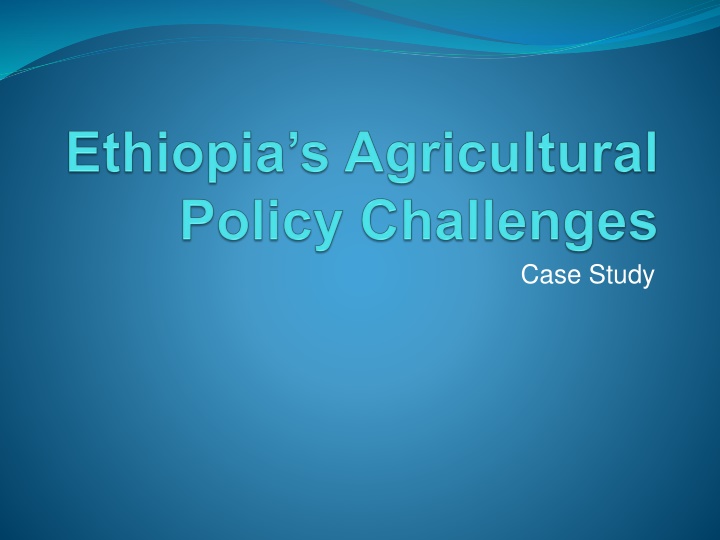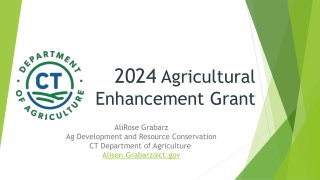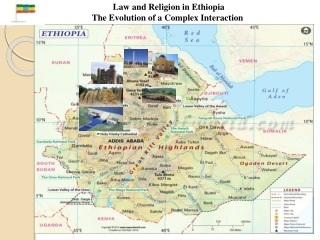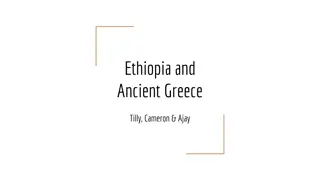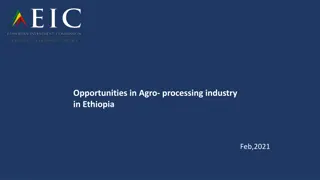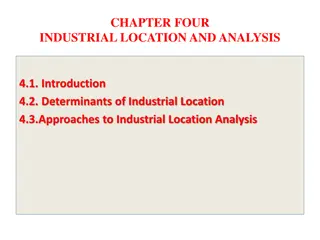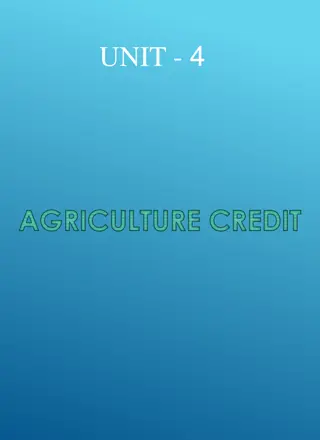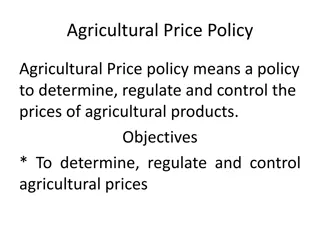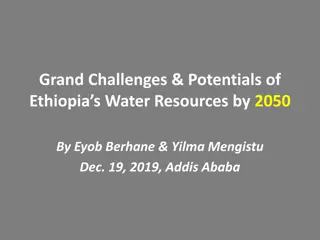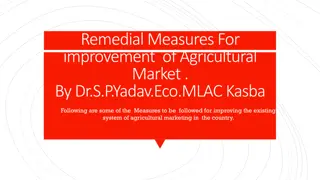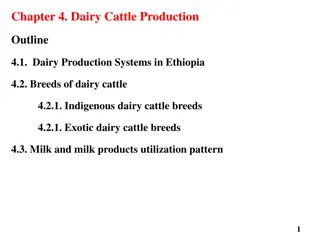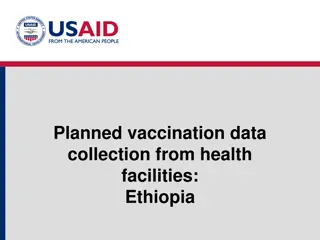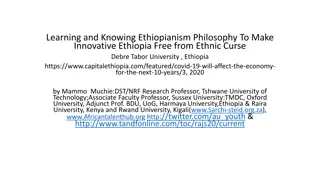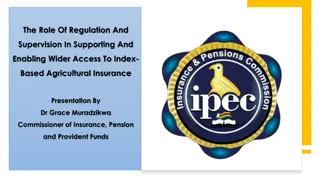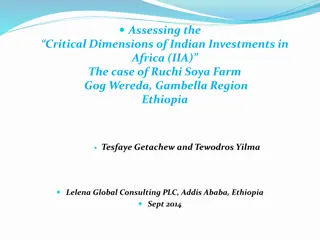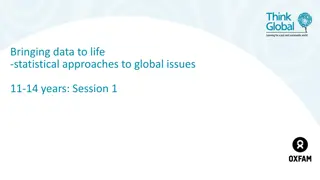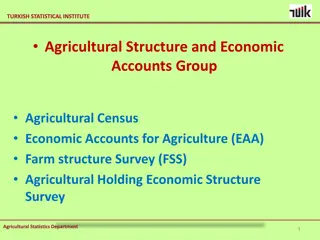Agricultural Development in Ethiopia
Agriculture plays a crucial role in the economic development of Ethiopia, with the sector serving as the backbone of the country's economy. The smallholder and large-scale farming sectors have distinct characteristics and histories, shaping the country's agricultural landscape. The post-1991 agricultural sector policy emphasizes agricultural-led industrialization, highlighting agriculture's lead role in development policies. Key dialogue questions revolve around whether agriculture or industry should be the lead sector for economic development, and the prioritization between smallholder farms and private commercial farms in the context of Ethiopian agriculture.
Download Presentation

Please find below an Image/Link to download the presentation.
The content on the website is provided AS IS for your information and personal use only. It may not be sold, licensed, or shared on other websites without obtaining consent from the author.If you encounter any issues during the download, it is possible that the publisher has removed the file from their server.
You are allowed to download the files provided on this website for personal or commercial use, subject to the condition that they are used lawfully. All files are the property of their respective owners.
The content on the website is provided AS IS for your information and personal use only. It may not be sold, licensed, or shared on other websites without obtaining consent from the author.
E N D
Presentation Transcript
Key Dialogue Questions (KDQ) 1. Should the lead sector for economic development be agriculture or industry, given that Ethiopia is a non oil-dependent developing country? 2. Should more priority be given to smallholder farms or private commercial farms, given the context of the agriculture sector of Ethiopia?
Role of agricultural sector in economic development of Ethiopia Agrarian and non-oil dependent developing country Agriculture is the backbone of its economy: main livelihood for > 85% of the population; accounts for about 45 % of GDP; almost 90 % of exports/foreign exchange earnings originate from agriculture sector; Main source of industrial raw materials for agro- industries. Two major sectors of agriculture: Smallholder and the large - scale farming sector
Smallholder sector Predominantly mixed crop and livestock semi-subsistence farming accounting for 83% - 95% of all cultivated land and of agricultural production low levels of modern inputs use and heavy dependence on rainfall vulnerable to the vagaries of nature (unpredictable rainfall & recurrent drought) Low productivity, very limited market share and insignificant saving and investment
Large -scale farming Ethiopia did not inherit colonial commercial farm. Growth of the sector started with the establishment of farms in the 1950s/60s (by elite, nobility, etc). The Derg/Military regime nationalized the farms to; Operate as state-owned enterprises after 1975: A ministry to manage & develop new state farms through the allocation of a large budget, Socialist policy (forbid land ownership > 10 ha) retarded growth of large scale private farm sector for 17 years Post1991 market and price liberalization which resulted in; the privatisation of many sate farms while the rest are still operating as parastatal/public enterprises Stimulated private investment in large scale commercial farm development by domestic and foreign) and the steady growth of the sector over the past two decades
Post 1991 Agricultural Sector policy Agricultural development -led industrialisation (ADLI); Lead- role of agriculture in development policy. Agriculture as the basis in the conceptualisation of growth, policy guidelines and poverty reduction. The key challenge for reducing poverty and providing the foundation for long-term growth is to ensure rapid and sustained increases in land and labour productivity. Agriculture is the main source to generate primary surplus that fuel the growth of other sectors notably, industry ADLI is made the policy in strategic development plan; Poverty reduction programme (SDPRP) and MDG Plan for Accelerated and Sustainable Development to End Poverty (PASDEP), for 2005-2009/10 Growth and Transformation Plan (GTP) strategic framework for the period 2010/11 -14/15.
Agricultural growth strategy ADLI strategy further refined during PASDEP with Emphasis on commercialisation of agriculture, strong private sector growth and intensification of marketable farm products. The fundamentals of the GTP strategy include: A shift to produce high value crops, a special focus on high-potential areas, facilitating the commercialization of agriculture, supporting the development of large-scale commercial agriculture (where it is feasible). PASDEP implementation as the main instrument for delivering agricultural growth through strong push for intensification to increase yield and productivity in the smallholder sector.
Public Expenditure Pattern A high share of expenditure for pro-poor and development oriented sectors Fig: Trends in pro-poor expenditure (%of total gov. expenditure) 16 14 %of total expenditure Education 12 10 Health 8 Road 6 4 Water 2 Agriculture and Rural Development 0
Public expenditure While average pro-poor expenditure was approximately 54% of total public expenditure (2001/02 2007/8), expenditure on agriculture and food security was about 12.6% of the total. Strong commitment to continued agricultural growth; about 13 to 17 % of expenditure (far more than the average for SSA). Food security nonetheless remains a key challenge as a large share of the sector budget goes to the Productive Safety Net Program (PSNP) & HH Asst Building Prog (HABP) GoE & DP realised that success in long-term food security will require complementary efforts to enhance agricultural growth, and thereby reduce food prices and diversify rural livelihoods. Thus, PADETES program for the intensification of smallholder agriculture during 1996/97 2004/05 EFY was allocated a large share of the agricultural growth expenditure.
PADETES program and performance To achieve strong push for intensification Three major Program components which are; Regular extension packages: for cereal crops which are mostly seed and fertilizer; Minimum packages: emphasizing natural resources management with traditional crop management); and Household packages: providing farm households a menu of technology (water harvesting, dairy, apiculture, and horticultural production).
PADETES Program PADETES capacity to deliver extension services Roughly 8,500 Farmer Training Centres (FTCs) have been created throughout Ethiopia, Development Agents (Das) trained increased from 2500 in 1995 to 63,000 (45,000 placed already in woredas/districts), Built DAs and woreda/district staff; trained with technical skills, and are as specialists, The development agent (DA) to farmer ratio had risen from 1:5000 to 1:800
Efficiency of Spending (PADETES) The program reached about 40% of the roughly 10 million farm households Succeeded in boosting input use (improved seed and fertilizer use increased by about 50 and 30%, respectively, from 1995 to 2005. Increased use of improved inputs/fertilizer rate (higher than the African average). But no change in average per capita agric. GDP and per capita grain production (results achieved are not as expected).
Large scale commercial farm Government support for the sector; Tax incentives/exemption from custom duties Infrastructure development (access road, power, other utilities, etc) Small land tax and grace period for payment Growth Performance of the large scale sector FDI inflow into agric. fluctuated between US$545mn & US$265mn/year from 2004-2007, From 2000 - 2005, floriculture/horticulture sector was the main focus of FDI Ethiopia is the 2nd largest flower exporter in Africa, (next to Kenya) Agricultural investment was about 15% in 2010.
Total capital of domestic and foreign investment projects approved, mill Birr (1992/03 - 2010/11) 180000 millions of Birr/year 160000 140000 120000 Domestic 100000 80000 Foreign 60000 40000 20000 0
Total agricultural investment capital of approved projects (2006/07 - 2010/11) 180000 Total capital, mill Birr/year) 160000 140000 120000 100000 Domestic Foreign 80000 60000 40000 20000 0 2006/07 2007/08 2008/09 2009/10 2010/11
Impacts of large scale farm growth Environmental concern and land grab Critics on the motives of FDI inflow, lack of long term growth impact; Primary aim to secure the food demand in the investors countries Financial returns instead of the traditional motives of efficiency and market-seeking Lack of technology transfer and spill-over effect on domestic/smallholder farmers (Out-growers?) Least impact on domestic market growth Evidence unavailable to justify government support (e. g., tax incentives) to sector growth
Conclusion: KDQ KDQ1: Is ADLI appropriate? Key arguments to increase the support for agriculture; Is the major contributor to GDP Has strong impact on poverty as it is source of livelihood Generates the major share of foreign exchange Provides raw materials for industry Comparative advantage (land and labour) to produce surplus production and generate capital to finance industrial growth Studies often show that growth based on agriculture makes a stronger contribution than industrial growth b/z agriculture has greater multiplier effects benefits from agricultural growth shared more equally
. Continued KDQ Key elements of the argument to increase support for industrial development are; the perception that support for agriculture has not been as effective as hoped. not clear yet whether public support for industry would experience challenges of a similar scale or nature to those experienced in the agricultural sector. the view that industrial development will create more employment (absorb the excess labour in agriculture and also reduce urban unemployment) others (create markets and demand for surplus supply of agricultural produces
. Continued KDQ KDQ 2: Should more priority be given to smallholder farms or private commercial farms, given the context of the agriculture sector of Ethiopia? strong M&E systems to evaluate the performance of support for both smallholders and large farms. Policy analysis to judge based on; The costs of support, including both the cost of delivering services and the loss of revenue arising from any tax incentives offered to investors in commercial farms The impact of the programmes on the production of crops and livestock, implications of changes in production and prices on the exchange rate and the effect of this on consumers. The implications of this for changes in the margins enjoyed by farmers, input suppliers and those involved in marketing produce.
